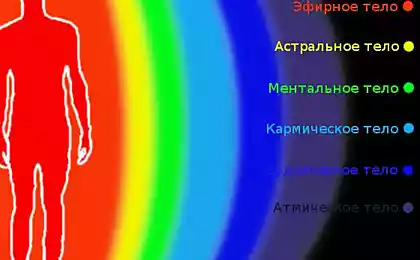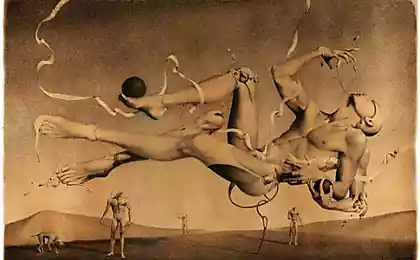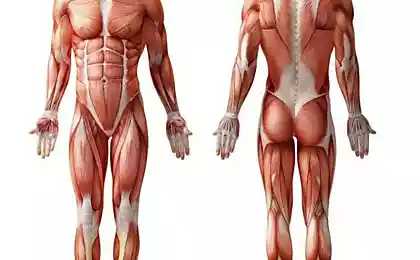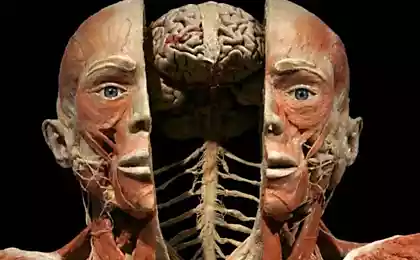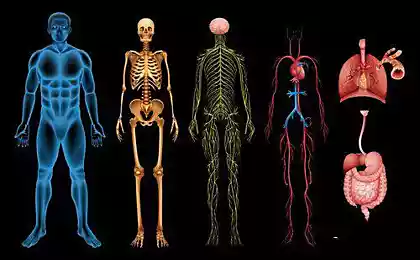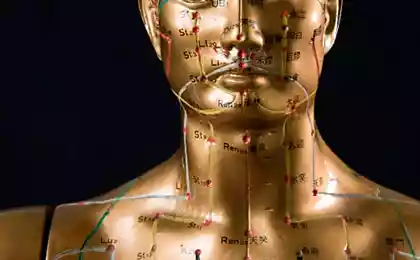636
little-known parts of the body
Little-known parts of the human body
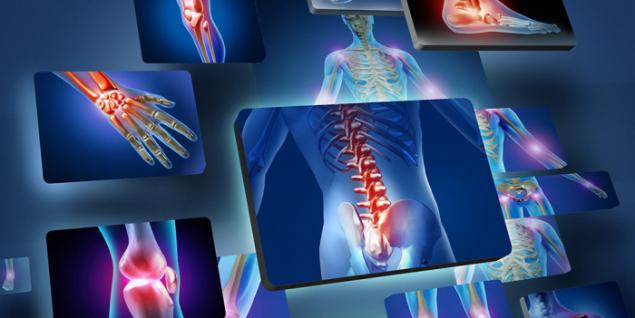
The human body - is a storehouse of puzzles. Our bodies and the system for a long centuries scrutinized, and especially impatient scientists even stole corpses to see - what is there all the same inside.
But to this day, there are parts of the body that remain unexplored. Some of our bodies laid obvious vital functions, while others seem to be or actually are useless. Still others are somewhere, or simply do not attract much attention. On the third of these will be discussed below.
What's out there in the knee
In November 2013, Belgian researchers first described the ligament in the human knee; she was named the anterolateral bundle. French surgeon first proposed the existence of this ligament in 1879, but so far its existence has not been proven.
The researchers argue that this discovery could shed light on the causes of some injury, when the knee of the patient moves during certain movements.
Layer Dyua
In another study, scientists have discovered a previously unknown layer in the human eye.
It's thin, durable structure, was named after its discoverer called "Dua layer", whose thickness is only 15 micrometers, or one millionth of a meter, and is located behind the cornea.
The opening of this layer will help researchers better understand some of the eye diseases that can be caused by trauma or rupture of this layer.
Additional ribs
Normally, the average person has 12 ribs on each side, but some people have found additional rib which, incidentally, can cause health problems.
This is called a cervical rib, and meets at 0, 05-3 per cent of people, research has shown. It grows from the base of the neck just above the collarbone, and are sometimes not fully formed, and consists of only a thin strip of fabric fibers.
Additional edge can lead to health problems if it presses on nearby blood vessels or nerve endings. This leads to a condition known as thoracic outlet syndrome, which is characterized by pain in the shoulder or neck, feeling the loss of limbs and the presence of clots in the blood.
Muscle allowing wiggle ears
Cats, dogs, and some lucky-people can wiggle their ears, using a group of muscles called Auriculares. This muscle group includes the front ear muscle that moves the ear forward; top, which picks it up and back, which pushes it back.
Although we all have these muscles, it is believed that only about 15 percent of people have the opportunity to use them, moving his ears. It was probably a useful skill in the days when the ancient people needed to turn an ear to the alarming sound. However, nowadays it can be useful only for entertainment.
Cuticle
Cuticle - a solid skin layer at the bottom of the nail where the nail enters the finger. Under the cuticle is in the process of forming a new nail. Almost invisible small part of our body to prevent ingress of dirt and bacteria in the body.
The hyoid bone
The hyoid bone is the only bone in the body, which is not connected with any other bone; it is the basis of the ability to speak and is found only in humans.
This horseshoe-shaped bone located in the throat between the chin and thyroid cartilage. Due to its location, the bone is working together with the larynx and tongue to utter a number of sounds.
The coccyx
The coccyx, or hvostets is formed at the confluence of the vertebrae, and is the residue of the tail, which is available in other mammals.
It has been suggested that the coccyx helps strengthen small muscles and support the pelvic organs. However, there have been many medical cases where the tailbone was surgically removed without any negative consequences.
Some medical cases describe babies who are born with an elongated coccyx. Today, on this unusual "tail" can be easy to get rid surgically, but in the Middle Ages it was believed that such a sign indicates a relationship with the devil, and such cases, the mother with her child executed.
Disappearing bones
Human skeletal system is full of wonders. Consider this: the adults have fewer bones than children. We are born with 350 bones, but because some of the bones fuse together over time, then, as adults, we are left with only 206 bones.
Restores stomach
To some extent this is a philosophical question, but it can be argued that every three or four days we have a new stomach. This is because the inner surface of our stomach constantly producing new cells. In fact, the stomach is constantly creating new layers to not be digested its own acid.
Philtrum
Podnosovoy groove, also sometimes called a filter is a vertical "notch" on the middle part of the upper lip.
In some animals due to him, perhaps, improved sense of smell as well as the area around the nose remained moist, but in humans this part of the body does not have a specific function.
It probably happened because modern people rely more on vision than any other feeling. Groove lost functionality, and remained only as a vestige of evolution.
However, scientists are still interested in this tiny part of the body, since it is formed at a certain stage of the embryo, and the unusual shape of the upper lip may be the key to the definition of irregularities in the development of the fetus.
©

The human body - is a storehouse of puzzles. Our bodies and the system for a long centuries scrutinized, and especially impatient scientists even stole corpses to see - what is there all the same inside.
But to this day, there are parts of the body that remain unexplored. Some of our bodies laid obvious vital functions, while others seem to be or actually are useless. Still others are somewhere, or simply do not attract much attention. On the third of these will be discussed below.
What's out there in the knee
In November 2013, Belgian researchers first described the ligament in the human knee; she was named the anterolateral bundle. French surgeon first proposed the existence of this ligament in 1879, but so far its existence has not been proven.
The researchers argue that this discovery could shed light on the causes of some injury, when the knee of the patient moves during certain movements.
Layer Dyua
In another study, scientists have discovered a previously unknown layer in the human eye.
It's thin, durable structure, was named after its discoverer called "Dua layer", whose thickness is only 15 micrometers, or one millionth of a meter, and is located behind the cornea.
The opening of this layer will help researchers better understand some of the eye diseases that can be caused by trauma or rupture of this layer.
Additional ribs
Normally, the average person has 12 ribs on each side, but some people have found additional rib which, incidentally, can cause health problems.
This is called a cervical rib, and meets at 0, 05-3 per cent of people, research has shown. It grows from the base of the neck just above the collarbone, and are sometimes not fully formed, and consists of only a thin strip of fabric fibers.
Additional edge can lead to health problems if it presses on nearby blood vessels or nerve endings. This leads to a condition known as thoracic outlet syndrome, which is characterized by pain in the shoulder or neck, feeling the loss of limbs and the presence of clots in the blood.
Muscle allowing wiggle ears
Cats, dogs, and some lucky-people can wiggle their ears, using a group of muscles called Auriculares. This muscle group includes the front ear muscle that moves the ear forward; top, which picks it up and back, which pushes it back.
Although we all have these muscles, it is believed that only about 15 percent of people have the opportunity to use them, moving his ears. It was probably a useful skill in the days when the ancient people needed to turn an ear to the alarming sound. However, nowadays it can be useful only for entertainment.
Cuticle
Cuticle - a solid skin layer at the bottom of the nail where the nail enters the finger. Under the cuticle is in the process of forming a new nail. Almost invisible small part of our body to prevent ingress of dirt and bacteria in the body.
The hyoid bone
The hyoid bone is the only bone in the body, which is not connected with any other bone; it is the basis of the ability to speak and is found only in humans.
This horseshoe-shaped bone located in the throat between the chin and thyroid cartilage. Due to its location, the bone is working together with the larynx and tongue to utter a number of sounds.
The coccyx
The coccyx, or hvostets is formed at the confluence of the vertebrae, and is the residue of the tail, which is available in other mammals.
It has been suggested that the coccyx helps strengthen small muscles and support the pelvic organs. However, there have been many medical cases where the tailbone was surgically removed without any negative consequences.
Some medical cases describe babies who are born with an elongated coccyx. Today, on this unusual "tail" can be easy to get rid surgically, but in the Middle Ages it was believed that such a sign indicates a relationship with the devil, and such cases, the mother with her child executed.
Disappearing bones
Human skeletal system is full of wonders. Consider this: the adults have fewer bones than children. We are born with 350 bones, but because some of the bones fuse together over time, then, as adults, we are left with only 206 bones.
Restores stomach
To some extent this is a philosophical question, but it can be argued that every three or four days we have a new stomach. This is because the inner surface of our stomach constantly producing new cells. In fact, the stomach is constantly creating new layers to not be digested its own acid.
Philtrum
Podnosovoy groove, also sometimes called a filter is a vertical "notch" on the middle part of the upper lip.
In some animals due to him, perhaps, improved sense of smell as well as the area around the nose remained moist, but in humans this part of the body does not have a specific function.
It probably happened because modern people rely more on vision than any other feeling. Groove lost functionality, and remained only as a vestige of evolution.
However, scientists are still interested in this tiny part of the body, since it is formed at a certain stage of the embryo, and the unusual shape of the upper lip may be the key to the definition of irregularities in the development of the fetus.
©
